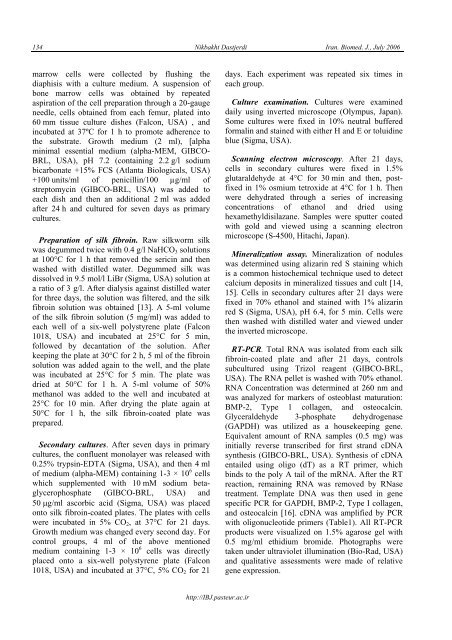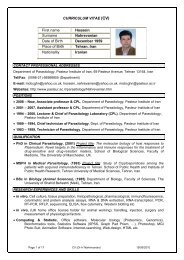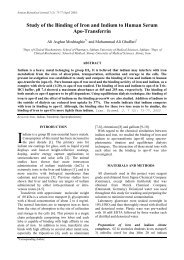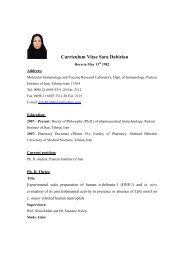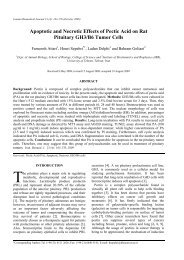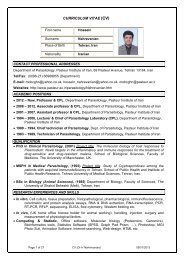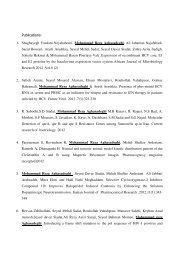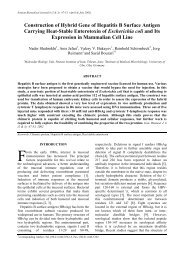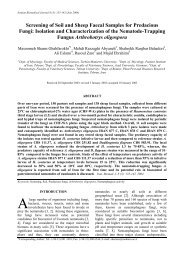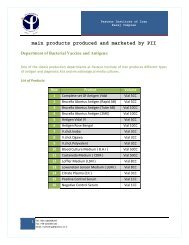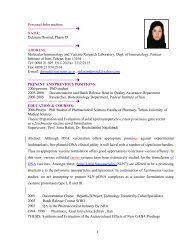Induction of Mineralized Nodule Formation in Rat Bone Marrow ...
Induction of Mineralized Nodule Formation in Rat Bone Marrow ...
Induction of Mineralized Nodule Formation in Rat Bone Marrow ...
You also want an ePaper? Increase the reach of your titles
YUMPU automatically turns print PDFs into web optimized ePapers that Google loves.
134 Nikbakht Dastjerdi Iran. Biomed. J., July 2006<br />
marrow cells were collected by flush<strong>in</strong>g the<br />
diaphisis with a culture medium. A suspension <strong>of</strong><br />
bone marrow cells was obta<strong>in</strong>ed by repeated<br />
aspiration <strong>of</strong> the cell preparation through a 20-gauge<br />
needle, cells obta<strong>in</strong>ed from each femur, plated <strong>in</strong>to<br />
60 mm tissue culture dishes (Falcon, USA) , and<br />
<strong>in</strong>cubated at 37ºC for 1 h to promote adherence to<br />
the substrate. Growth medium (2 ml), [alpha<br />
m<strong>in</strong>imal essential medium (alpha-MEM, GIBCO-<br />
BRL, USA), pH 7.2 (conta<strong>in</strong><strong>in</strong>g 2.2 g/l sodium<br />
bicarbonate +15% FCS (Atlanta Biologicals, USA)<br />
+100 units/ml <strong>of</strong> penicill<strong>in</strong>/100 µg/ml <strong>of</strong><br />
streptomyc<strong>in</strong> (GIBCO-BRL, USA) was added to<br />
each dish and then an additional 2 ml was added<br />
after 24 h and cultured for seven days as primary<br />
cultures.<br />
Preparation <strong>of</strong> silk fibro<strong>in</strong>. Raw silkworm silk<br />
was degummed twice with 0.4 g/l NaHCO 3 solutions<br />
at 100°C for 1 h that removed the seric<strong>in</strong> and then<br />
washed with distilled water. Degummed silk was<br />
dissolved <strong>in</strong> 9.5 mol/l LiBr (Sigma, USA) solution at<br />
a ratio <strong>of</strong> 3 g/l. After dialysis aga<strong>in</strong>st distilled water<br />
for three days, the solution was filtered, and the silk<br />
fibro<strong>in</strong> solution was obta<strong>in</strong>ed [13]. A 5-ml volume<br />
<strong>of</strong> the silk fibro<strong>in</strong> solution (5 mg/ml) was added to<br />
each well <strong>of</strong> a six-well polystyrene plate (Falcon<br />
1018, USA) and <strong>in</strong>cubated at 25°C for 5 m<strong>in</strong>,<br />
followed by decantation <strong>of</strong> the solution. After<br />
keep<strong>in</strong>g the plate at 30°C for 2 h, 5 ml <strong>of</strong> the fibro<strong>in</strong><br />
solution was added aga<strong>in</strong> to the well, and the plate<br />
was <strong>in</strong>cubated at 25°C for 5 m<strong>in</strong>. The plate was<br />
dried at 50°C for 1 h. A 5-ml volume <strong>of</strong> 50%<br />
methanol was added to the well and <strong>in</strong>cubated at<br />
25°C for 10 m<strong>in</strong>. After dry<strong>in</strong>g the plate aga<strong>in</strong> at<br />
50°C for 1 h, the silk fibro<strong>in</strong>-coated plate was<br />
prepared.<br />
Secondary cultures. After seven days <strong>in</strong> primary<br />
cultures, the confluent monolayer was released with<br />
0.25% tryps<strong>in</strong>-EDTA (Sigma, USA), and then 4 ml<br />
<strong>of</strong> medium (alpha-MEM) conta<strong>in</strong><strong>in</strong>g 1-3 × 10 6 cells<br />
which supplemented with 10 mM sodium betaglycerophosphate<br />
(GIBCO-BRL, USA) and<br />
50 µg/ml ascorbic acid (Sigma, USA) was placed<br />
onto silk fibro<strong>in</strong>-coated plates. The plates with cells<br />
were <strong>in</strong>cubated <strong>in</strong> 5% CO 2 , at 37°C for 21 days.<br />
Growth medium was changed every second day. For<br />
control groups, 4 ml <strong>of</strong> the above mentioned<br />
medium conta<strong>in</strong><strong>in</strong>g 1-3 × 10 6 cells was directly<br />
placed onto a six-well polystyrene plate (Falcon<br />
1018, USA) and <strong>in</strong>cubated at 37°C, 5% CO 2 for 21<br />
days. Each experiment was repeated six times <strong>in</strong><br />
each group.<br />
Culture exam<strong>in</strong>ation. Cultures were exam<strong>in</strong>ed<br />
daily us<strong>in</strong>g <strong>in</strong>verted microscope (Olympus, Japan).<br />
Some cultures were fixed <strong>in</strong> 10% neutral buffered<br />
formal<strong>in</strong> and sta<strong>in</strong>ed with either H and E or toluid<strong>in</strong>e<br />
blue (Sigma, USA).<br />
Scann<strong>in</strong>g electron microscopy. After 21 days,<br />
cells <strong>in</strong> secondary cultures were fixed <strong>in</strong> 1.5%<br />
glutaraldehyde at 4°C for 30 m<strong>in</strong> and then, postfixed<br />
<strong>in</strong> 1% osmium tetroxide at 4°C for 1 h. Then<br />
were dehydrated through a series <strong>of</strong> <strong>in</strong>creas<strong>in</strong>g<br />
concentrations <strong>of</strong> ethanol and dried us<strong>in</strong>g<br />
hexamethyldisilazane. Samples were sputter coated<br />
with gold and viewed us<strong>in</strong>g a scann<strong>in</strong>g electron<br />
microscope (S-4500, Hitachi, Japan).<br />
M<strong>in</strong>eralization assay. M<strong>in</strong>eralization <strong>of</strong> nodules<br />
was determ<strong>in</strong>ed us<strong>in</strong>g alizar<strong>in</strong> red S sta<strong>in</strong><strong>in</strong>g which<br />
is a common histochemical technique used to detect<br />
calcium deposits <strong>in</strong> m<strong>in</strong>eralized tissues and cult [14,<br />
15]. Cells <strong>in</strong> secondary cultures after 21 days were<br />
fixed <strong>in</strong> 70% ethanol and sta<strong>in</strong>ed with 1% alizar<strong>in</strong><br />
red S (Sigma, USA), pH 6.4, for 5 m<strong>in</strong>. Cells were<br />
then washed with distilled water and viewed under<br />
the <strong>in</strong>verted microscope.<br />
RT-PCR. Total RNA was isolated from each silk<br />
fibro<strong>in</strong>-coated plate and after 21 days, controls<br />
subcultured us<strong>in</strong>g Trizol reagent (GIBCO-BRL,<br />
USA). The RNA pellet is washed with 70% ethanol.<br />
RNA Concentration was determ<strong>in</strong>ed at 260 nm and<br />
was analyzed for markers <strong>of</strong> osteoblast maturation:<br />
BMP-2, Type 1 collagen, and osteocalc<strong>in</strong>.<br />
Glyceraldehyde 3-phosphate dehydrogenase<br />
(GAPDH) was utilized as a housekeep<strong>in</strong>g gene.<br />
Equivalent amount <strong>of</strong> RNA samples (0.5 mg) was<br />
<strong>in</strong>itially reverse transcribed for first strand cDNA<br />
synthesis (GIBCO-BRL, USA). Synthesis <strong>of</strong> cDNA<br />
entailed us<strong>in</strong>g oligo (dT) as a RT primer, which<br />
b<strong>in</strong>ds to the poly A tail <strong>of</strong> the mRNA. After the RT<br />
reaction, rema<strong>in</strong><strong>in</strong>g RNA was removed by RNase<br />
treatment. Template DNA was then used <strong>in</strong> gene<br />
specific PCR for GAPDH, BMP-2, Type I collagen,<br />
and osteocalc<strong>in</strong> [16]. cDNA was amplified by PCR<br />
with oligonucleotide primers (Table1). All RT-PCR<br />
products were visualized on 1.5% agarose gel with<br />
0.5 mg/ml ethidium bromide. Photographs were<br />
taken under ultraviolet illum<strong>in</strong>ation (Bio-Rad, USA)<br />
and qualitative assessments were made <strong>of</strong> relative<br />
gene expression.<br />
http://IBJ.pasteur.ac.ir


